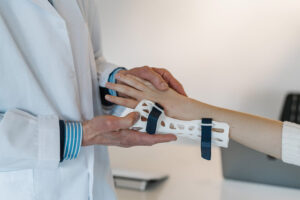Adults and kids alike are spending as much as 50 percent more time using digital devices than they did two years ago. In our pandemic-altered digital reality, kids and teens have been most affected by the lure of the screen spending several hours a day using devices for school, socializing, and gaming. While it is unlikely that this digital dependence will disappear any time soon, there are simple changes to make so that time spent online is healthier-providing a barrier against the health-compromising effects of screen surfing.
Screentime Up, Wellbeing Down
In the United States, children ages 8 to 12 spend an average of four to six hours daily interacting with digital devices including phones, tablets, computers, gaming devices, and TV. Teens can spend up to 9 hours a day or more in front of screens. Researchers worldwide have shown that this increase in screen time has detrimental effects on physical and psychosocial wellbeing.
Physical Effects of Too Much Screen Time:
- Sleep disruptions (difficulty falling/staying asleep; lower quality of sleep)
- Eye strain, blurry or double vision
- Fatigue
- Headache/migraine
- Neck pain
- Low back pain
- Joint and muscle stiffness
- Weight gain
Psychosocial Effects of Too Much Screen Time:
- Increased feelings of depression and anxiety
- Mood instability
- Poor body image
- Reduced time spent in outdoors
- Poor communication skills
The increase in screentime is also significantly associated with increased rates of ADHD, behavior disorders, violent outbursts, poor school performance, clinical anxiety and/or depression, mood disorders, disordered eating and body image perception. These detrimental effects are universal to people of all ages but are even more concerning for young people whose minds and bodies are still developing.
How Does Time in Front of Digital Devices Diminish Health?
All devices emit blue light wavelengths, something which used to only come from the sun. Compared to red or green light waves, blue light waves are shorter with a higher energy output. During daylight hours, blue light has its benefits: It has been shown to boost attention, reaction times, and mood. Digital devices, however, have brought blue light indoors, where we are exposed at all hours of the day. The disruption to health is particularly pertinent with nighttime use of blue light emitting devices. This is why many devices have a blue light filter (e.g. Night Shift on Apple devices). This does not change the impact, however, that persistent use of devices is having on the eyes, headaches, sleep patterns, and brain development, particularly in regard to focus and attention.
Research has shown that nighttime exposure to blue wavelengths suppresses the release of melatonin, a hormone that influences circadian rhythms and sleep patterns. Even with a filter, late night use of devices has negative effects on sleep hygiene and health. When sleep is disrupted, there is a cascade effect in the body causing changes in mood, appetite, metabolism, and the body’s ability to recover. Over time, poor sleep can lead to mood disturbances, weight gain, less resilience to stress, and decreased immunity.
5 Tips for Screen Time a Healthier Way
Don’t Start the Day Online. Kids these days use their devices as alarm clocks. They reach for it and dive into checking messages. Encourage your kids to use a regular alarm clock. More importantly, set boundaries around allowing mobile devices in the bedroom where they cannot be monitored, especially at night. One option is to leave phones in the kitchen or another “device zone” in the house.
Set a Time Limit for Online Tasks. It is easy to get lured down the digital rabbit hole. Set a timer for completing online tasks. This kind of online task/time management will enhance focus, reduce stress, and allow you to have more time for other things that matter to you.
Schedule Time Offline, Outdoors. It is crucial to have time away from all devices, out in the sunshine and fresh air. Collect the phone from your kids and tell them they can earn screen time after they’ve spent time outside without a device. Be sure they are outside moving and when at all possible, schedule this time as a family activity. Biking, swimming, mini golf, and sports are ideal because they don’t allow the use of phones while engaged in the activity.
Hobbies Can Distract Kids from their Devices. When the weather is bad, visit a museum, pick out new library books, or go to a craft store and learn to sculpt clay or paint. Help kids find a hobby they enjoy so much they won’t want to be on their devices for a few hours.
Manage Social Channels Cautiously. The research is still emerging, but the outlook is not good for social channels such as Instagram, Discord, and SnapChat. Recent studies have shown that activity on these networks has a negative impact on emotional wellbeing, particularly self-worth, body image, and mental health. While these channels are trying to counteract negative influences, it’s an uphill battle. Kids (and adults) need to be selective about which of the social media channels they want to use and why. It is important to speak to your kids about the legal and health implications of using social networks, how to select which are age-appropriate, and how to use them responsibly.
These days every device comes with some type of built-in screen time monitoring that parents can control across devices. Once a child reaches a certain age, those parental limits can be deactivated. Make sure you know how the parental settings work on your devices. Additionally, there are several types of digital monitoring apps on the market. Do your research to find the app that best suits your device types and the needs of your family. As you make decisions about screen time boundaries and how it will be monitored, remember the foundation for safe and healthy online activity comes with open communication with your kids about what is expected and what the consequences are if the rules are broken.
Our focus is on you, the parents, and helping you navigate your health. We’ve put together a Supplement Protocol for Parents to help you with your stress and immune support.
Resources
Kershner, M. A. Kids and Their Screens: A Healthier Way to Use Them. Norman, OK: Vital Health Publishing, 2021.
Kershner, M. A. Working from Home: Mastering the Art of Sitting at Your Computer. Norman, OK: Vital Health Publishing, 2021.
Family Zone. “Five Easy Ways to Make Screen-Time Healthier and More Satisfying.” https://www.familyzone.com/anz/families/blog/five-easy-ways-to-make-screen-time-healthier
Raising Children Network. “Teenage Screen Time: Tips for Balance.” https://raisingchildren.net.au/teens/entertainment-technology/screen-time-healthy-screen-use/healthy-screen-time-teens
Raising Children Network. “School-Age Screen Time: Tips for Balance.” https://raisingchildren.net.au/school-age/play-media-technology/screen-time-healthy-screen-use/healthy-screen-time-6-11-years







